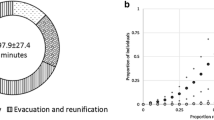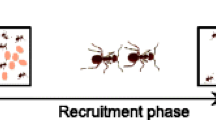Abstract
Colonies of the ant Temnothorax albipennis improve their collective performance over successive emigrations (Langridge et al. Behav Ecol Sociobiol 56:523–529, 2004, Behav Ecol Sociobiol 62:447–456, 2008). Here, by analysing the performance of individual transporters (workers that carry the brood, queen and a proportion of adults), we investigate whether they spend less time at the old and new nests during repeated emigrations. Transporters expedited choosing and picking up brood items at the old nest and depositing them in the new nest. Such improvements were not associated with adult transport. Generally, when carrying brood items, but not when carrying adults, transporters visited several locations in the new nest before depositing them. Transporters did not interact with other adults when depositing brood items. Consequently, reductions in depositing times are the sum of time savings made by individual transporters. By contrast, transporters spent most time interacting with other adults before picking up brood items at the old nest. As the frequency of these interactions did not decline, we suggest the behaviours of interacting adults were modified in a way that hastened their completion. Thus, reductions in picking-up times probably occur because of time saved during interactions.





Similar content being viewed by others
References
Collett TS, Collett M (2002) Memory use in insect navigation. Nat Rev Neurosci 3:542–552
Dornhaus A, Franks NR, Hawkins RM, Shere HNS (2004) Ants move to improve: colonies of Leptothorax albipennis emigrate whenever they find a superior nest site. Anim Behav 67:959–963
Dukas R, Real LA (1991) Learning foraging tasks by bees: a comparison between social and solitary species. Anim Behav 42:269–276
Franks NR (1989) Army ants: a collective intelligence. Am Sci 77:138–145
Franks NR, Sendova-Franks AB (2000) Queen transport during ant colony emigration: a group-level adaptive behaviour. Behav Ecol 11:315–318
Franks NR, Pratt SC, Mallon EB, Britton NF, Sumpter DJT (2002) Information flow, opinion polling and collective intelligence in house-hunting social insects. Philos Trans R Soc Lond B 357:1567–1583
Franks NR, Dornhaus A, Fitzsimmons JP, Stevens M (2003a) Speed versus accuracy in collective decision making. Proc R Soc Lond B 270:2457–2463
Franks NR, Mallon EB, Bray HE, Hamilton MJ, Mischler TC (2003b) Strategies for choosing between alternatives with different attributes exemplified by house-hunting ants. Anim Behav 65:215–223
Giurfa M, Zhang S, Jennett A, Menzel R, Srinivasan V (2001) The concept of “sameness and “difference” in an insect. Nature 410:930–933
Gordon DM (1996) The organization of work in social insect colonies. Nature 380:121–124
Hatcher MJ, Tofts C, Franks NR (1992) Mutual exclusion as a mechanism for information exchange within ant nests. Naturwissenschaften 79:32–34
Hölldobler B, Wilson EO (1990) The ants. Belknap Press of Harvard University Press, Cambridge
Johnson RA (1991) Learning, memory and foraging efficiency in two species of desert seed-harvester ants. Ecology 72:1408–1419
Judd SPD, Collett TS (1998) Multiple stored views and landmark guidance in ants. Nature 392:710–714
Langridge EA, Franks NR, Sendova-Franks AB (2004) Improvement in collective performance with experience in ants. Behav Ecol Sociobiol 56:523–529
Langridge EA, Sendova-Franks AB, Franks NR (2008) How experienced individuals contribute to an improvement in collective performance in ants. Behav Ecol Sociobiol 62:447–456
Lewis LA, Schneider SS (2000) The modulation of worker behavior by the vibration signal during house hunting in swarms of the honeybee, Apis mellifera. Behav Ecol Sociobiol 48:154–164
Mallon EB, Franks NR (2000) Ants estimate area by using Buffon’s needle. Proc R Soc Lond B 267:765–770
Mallon EB, Pratt SC, Franks NR (2001) Individual and collective decision-making during nest site selection by the ant Leptothorax albipennis. Behav Ecol Sociobiol 50:352–359
Markl H (1985) Manipulation, modulation, information, cognition: some of the riddles of communication. In: Hölldobler B, Lindauer M (eds) Experimental behavioural ecology and socio-biology. Fischer Verlag, Stuttgart
Meddis R (1984) Statistics using ranks: a unified approach. Basil Blackwell, Oxford
Menzel R (1985) Learning in honeybees in an ecological and behavioural context. In: Hölldobler B, Lindauer M (eds) Experimental behavioural ecology and socio-biology. Fischer Verlag, Stuttgart, pp 55–74
Menzel R (1999) Memory dynamics in the honeybee. J Comp Physiol A 135:323–340
Mugford ST, Mallon EB, Franks NR (2001) The accuracy of Buffon’s needle: a rule of thumb used by ants to estimate area. Behav Ecol 12:655–658
Page EB (1963) Ordered hypotheses for multiple treatments: a significance test for linear ranks. J Am Stat Assoc 58:216–230
Pratt SC (2005) Quorum sensing by encounter rates in the ant Temnothorax albipennis. Behav Ecol 16:488–496
Pratt SC, Mallon EB, Sumpter DJT, Franks NR (2002) Quorum sensing, recruitment and collective decision-making during colony emigration by the ant Leptothorax albipennis. Behav Ecol Sociobiol 52:117–127
Schneirla TC (1943) The nature of learning, II The intermediate stage of segemental maze adjustment. J Comp Psychol 35:149–176
Seeley TD (1997) Honey bee colonies are group-level adaptive units. Am Nat 150:S22–S41
Seeley TD, Visscher PK (2003) Choosing a home: how the scouts in a honeybee swarm perceive the completion of their group decision-making. Behav Ecol Sociobiol 54:511–520
Sendova-Franks AB, Franks NR (1993) Task allocation in ant colonies within variable environments (a study of temporal polyethism: experimental). Bull Math Biol 55:75–96
Sendova-Franks AB, Franks NR (1995a) Division of labour in a crisis: task allocation during colony emigration in the ant Leptothorax unifasciatus (Latr.). Behav Ecol Sociobiol 36:269–282
Sendova-Franks AB, Franks NR (1995b) Spatial relationships within nests of the ant Leptothorax unifasciatus (Latr.). Anim Behav 50:121–136
Siegal S, Castellan NJ (1988) Nonparametric statistics for the behavioural sciences. McGraw-Hill, New York
Sokal RR, Rohlf FJ (1995) Biometry. Freeman, New York
Weidenmüller A (2004) The control of nest climate in bumblebee (Bombus terrestris) colonies: interindividual variability and self reinforcement in fanning response. Behav Ecol 15:120–128
Wilson EO (1985) Between-caste aversion as a basis for division of labor in the ant Pheidole pubiventris (Hymenoptera:Formicidae). Behav Ecol Sociobiol 17:35–37
Acknowledgements
The experiment reported in this study complied with the current laws of the UK. We would like to thank Nathalie Stroeymeyt for comments that improved this paper.
Author information
Authors and Affiliations
Corresponding author
Additional information
Communicated by: M. Beekman
Rights and permissions
About this article
Cite this article
Langridge, E.A., Sendova-Franks, A.B. & Franks, N.R. The behaviour of ant transporters at the old and new nests during successive colony emigrations. Behav Ecol Sociobiol 62, 1851–1861 (2008). https://doi.org/10.1007/s00265-008-0614-4
Received:
Revised:
Accepted:
Published:
Issue Date:
DOI: https://doi.org/10.1007/s00265-008-0614-4




